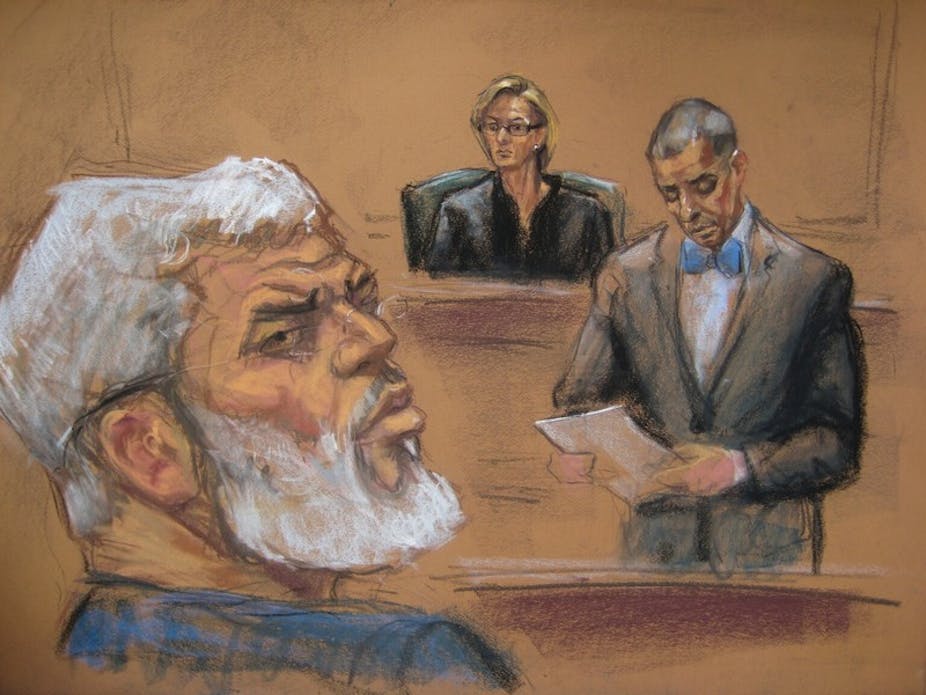This week saw the convictions of two men at opposite ends of the process of radicalisation – one convicted for radicalising others, the other for being radicalised himself.
In the United States, a court in New York found Abu Hamza al-Masri guilty of involvement in several violent plots, the state’s attorney general arguing he was “not just a preacher of faith, but a trainer of terrorists.” Among other things, Hamza was accused of radicalising young Muslims to fight in conflicts around the world.
Meanwhile, a British court convicted Mashudur Choudhury, a 31-year-old father of two from Portsmouth, who travelled to Syria intending to fight in the ongoing civil war. Choudhury was apparently radicalised into believing that his violent contribution to the war was ideologically necessary. Though there is no evidence that he actually fought there, he was found guilty of seeking to join the conflict for an ideological cause.
But even as both courts handed down decisive custodial sentences, there is still a good deal of confusion about how the process of violent radicalisation works, how it links men like Hamza to men like Choudhury – and exactly what role radical ideology, so central in both cases, actually plays in acts of radical violence.
Bad religion?
There is no consensus among researchers on exactly how radicalisation motivates people to commit violent actions. There are, however, some significant trends in the research, especially regarding the role of ideology, that can help us get to the real implications of these two very different cases.
In one camp are those who think that religion has everything to do with violent behaviour, and can reasonably be described as its primary cause. The existence of billions of non-violent religious believers hardly supports this point of view, but it nevertheless remains popular. More considered, and better researched, versions of this stance see religion playing a specific but highly qualified role in violence.
Other researchers, however, have argued convincingly that this approach defines religion so loosely that it can never explain religious radicals’ violent behaviour.
In my own work on this topic, I have suggested that rather than focusing on the role religion plays in driving people to violence, we should focus on the importance of non-negotiable beliefs in general, religious or otherwise – the things we hold to be sacred. This category can encompass the flags of our countries or our children as much as prophets or the ideas expressed in holy texts, and by using it, we can broaden our ideas about what makes some radicalised people violent.
The in-crowd
Many people in the field have already started doing this work. The anthropologist Scott Atran has written about the role sacred ideas play in violence. Having carried out research with people involved in fighting in several conflict zones around the world, he is clear that people do not kill for an ideology; instead, they take part in violent behaviour because of the influence of their peer groups.
And there are other common factors behind the slide into violence. Radicalised people who act violently have often previously felt that they are worse off than other people, and don’t feel that they have the means or opportunities to improve their situation (regardless of whether this is strictly true). It is these people’s engagement with a peer network which encourages violence, occasionally over the internet but more commonly in person.
Note that in Choudhury’s case, it was conversations with a friend already out in Syria which apparently encouraged him to go there; when he did, he went with a number of friends from his home town of Portsmouth. Given his history of lying and deceiving even his own family, including by falsely claiming he had stomach cancer, he seems unlikely to have acted because of a long-standing and deepening commitment to a religious ideological cause.
Instead, the lack of clarity in Choudhury’s life chimes with studies that have shown how people struggling with personal uncertainty can become more extreme in their social attitudes – and are also vulnerable to the appeal of groups which take a hard, judgemental line against non-members.
It has been argued that we should not confuse radicalisation with the actual practice of terrorism. After all, a great many terrorists are not committed to a radical ideology, just as many radicals are not terrorists. And the policy ramifications of focusing too specifically on ideological radicalisation in itself are potentially very serious indeed.
In short, we’re missing a trick by looking too closely at the ideological side of radicalisation, and we need to do more to find and understand the real pathways that take people into terrorism – and indeed, the path back out again.
Both recently sentenced men provide us with glaring examples. In Choudhury’s case, what mattered was who he travelled with and why, not what he believed in. And when it comes to dealing with people like Abu Hamza, we must pay attention to the specific social networks they inspire and empower – not just anyone who might believe what they say.
And while we must pay attention to violent radical ideology itself, we must also acknowledge that it’s only one of the many forces that drive violent radicalisation.

